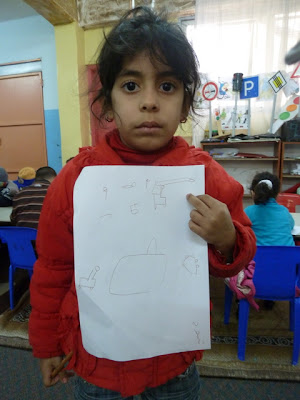During the last week of February, MwB-trainers Otto and Marijke traveled again to Bethlehem for a training week. About 20 social workers, divided into two groups, participated and learned new musical skills that they can use during their daily work.


 |
| MwB trainer Otto shares movements to accompany the song "Elena" |
The last training day was dedicated to the presentation of miniature workshops executed by the trainees. A lot of creativity and didactic and pedagogical skills were portrayed during these workshops: Zahra from Aida refugee camp enchanted us all with her imaginary bird that went from hand to hand before it was freed into the sky.
 |
Zahra started her workshop with a name game in which all participants
were connected with each other trough a red string. At the end of the workshop,
we were connected once again by sharing the imaginary bird with each other. |
Maysa from al-Azzeh refugee camp made everyone laugh with her version of "Layla al-Hamra", the Arabic Little Red Riding Hood. Some participants were concerned that young children might be afraid of the wolf (in Maysa's version a tiger), what led to an interesting discussion about protecting young children from anything scary or exposing them to scary stories to prepare them to real life, which is also not always about red capes, picnics and beautiful forests.
 |
The workshop of Maysa and Lotus designed for kindergarten children
started with a name game in the shape of a train |
 |
| Little Red Riding Hood and the Tiger |

 |
After the story of Maysa, Lotus from Hebron does an activity with balloons,
teaching the participants about the color "red" |
Halima taught us how to say apple, cat, lion, zoo, and many other words in sign language by using a funny ABC-video and by creating a dance that expressed all different words in sign language. Thanks to the translation by her sister Majda and her precise observation of the trainers, Halima is able to follow the music leadership training without hearing a single word.
As an introduction to his workshop, Rasheed from Beit Ummar explained to us why he would sing and make movements with the song during his workshop. He showed us the following drawing, and explained that the upper part is our brain, and the lower part our emotional world, our feelings.
 |
| The drawing of Rasheed |
The lower part is under water and not visible for others, unless we express our feelings. The border between the brain and feelings is open and there is a connection, as well as between the brain and the surrounding space (our environment) and the feelings and the surrounding space. But if we work too hard, sometimes the border between our feelings and surrounding space can be shut, and if we really work too hard the border between the brain and feelings also closes, what can lead to serious problems. To relax and de-stress and (re-)open these borders, he suggested we would sing and move together, so we could continue our day afterward fresh and relaxed.
 |
MwB trainer Marijke explains different goals of a music workshop,
which includes musical and social goals |
Another creative idea came from Rasheed: he was asked to mediate in a school were there was a big fight between teachers. The situation had reached a point that some of the teachers even refused to talk with each other. Rasheed planned to use one of the dances that Marijke had done during the training, in which participants shake each other's hands and change partners many times in order to shake everyone's hands. He expressed his hope that the funny music accompanying this simple dance would release the tense atmosphere and bring the teachers closer to each other again.
Starting next week, all trainees will receive six Nonviolence workshops organized by Holy Land Trust and they will continue using their new skills in their daily work. For the next weeks, workshops will be given to youth in an agricultural boarding school, to children in Hebron, and to kindergarten children in al-Azzeh refugee camp.
We would like to thank
Ghirass Cultural Center for hosting the second training week in their beautiful building, the translators Muna, Ameera, Mohamad and Fuad for their patience and precise translation, the trainee Majda for translating to sign language, and all the trainees and trainers for their valuable input, creativity, and participation!




































